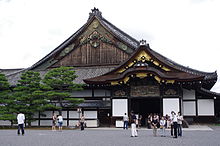Japanese architecture has traditionally been typified by wooden structures, elevated slightly off the ground, with tiled or thatched roofs. Sliding doors (fusuma) were used in place of walls, allowing the internal configuration of a space to be customized to different occasions. People usually sat on cushions or otherwise on the floor, traditionally; chairs and high tables were not widely used until the 19th century. Since the 19th century, however, Japan has incorporated much of Western, modern, andpost-modern architecture into construction and design, and is today a leader in cutting-edge architectural design and technology.
The earliest Japanese architecture was seen in prehistoric times in simple pit-houses and stores that were adapted to a hunter-gatherer population. Influence from Han Dynasty China via Korea saw the introduction of more complex grain stores and ceremonial burial chambers.
The introduction into Japan of Buddhism in the sixth century was a catalyst for large scale temple building using complicated techniques in wood. Influence from the Chinese T'ang and Sui Dynasties led to the foundation of the first permanent capital in Nara. Its checkerboard street layout used the Chinese capital of Chang'an as a template for its design. A gradual increase in the size of buildings led to standard units of measurement as well as refinements in layout and garden design. The introduction of the tea ceremony emphasised simplicity and modest design as a counterpoint to the excesses of the aristocracy.
During the Meiji Restoration of 1868 the history of Japanese architecture was radically changed by two important events. The first was the Kami and Buddhas Separation Act of 1868, which formally separated Buddhism from Shinto and Buddhist temples from Shinto shrines, breaking an association between the two which had lasted well over a thousand years and causing, directly and indirectly, immense damage to the nation's architecture.[1]
Second, it was then that Japan underwent a period of intense Westernization in order to compete with other developed countries. Initially architects and styles from abroad were imported to Japan but gradually the country taught its own architects and began to express its own style. Architects returning from study with western architects introduced theInternational Style of modernism into Japan. However, it was not until after the Second World War that Japanese architects made an impression on the international scene, firstly with the work of architects like Kenzo Tange and then with theoretical movements like Metabolism.
General features of Japanese traditional architecture
Much in the traditional architecture of Japan is not native, but was imported from China and other Asian cultures over the centuries. Japanese traditional architecture and its history are as a consequence dominated by Chinese and Asian techniques and styles (present even in Ise Shrine, held to be the quintessence of Japanese architecture) on one side, and by Japanese original variations on those themes on the other.[2]
Partly due also to the variety of climates in Japan and the millennium encompassed between the first cultural import and the last, the result is extremely heterogeneous, but several practically universal features can nonetheless be found. First of all is the choice of materials, always wood in various forms (planks, straw, tree bark, paper, etc.) for almost all structures. Unlike both Western and some Chinese architecture, the use of stone is avoided except for certain specific uses, for example temple podia and pagoda foundations.[2]
The general structure is almost always the same: posts and lintels support a large and gently curved roof, while the walls are paper-thin, often movable and in any case non-carrying. Arches and barrel roofs are completely absent. Gable and eave curves are gentler than in China and columnar entasis (convexity at the center) limited.[2]
The roof is the most visually impressive component, often constituting half the size of the whole edifice.[2] The slightly curved eaves extend far beyond the walls, covering verandas, and their weight must therefore be supported by complex bracket systems called tokyō, in the case of temples and shrines. Simpler solutions are adopted in domestic structures. The oversize eaves give the interior a characteristic dimness, which contributes to the building's atmosphere. The interior of the building normally consists of a single room at the center called moya, from which depart any other less important spaces.
Inner space divisions are fluid, and room size can be modified through the use of screens or movable paper walls. The large, single space offered by the main hall can therefore be divided according to the need.[2] To the contrary, some walls can be removed and different rooms joined temporarily to make space for some more guests. The separation between inside and outside is itself in some measure not absolute as entire walls can be removed, opening a residence or temple to visitors. Verandas appear to be part of the building to an outsider, but part of the external world to those in the building. Structures are therefore made to a certain extent part of their environment. Care is taken to blend the edifice into the surrounding natural environment.[2]
The use of construction modules keeps proportions between different parts of the edifice constant, preserving its overall harmony.[2] (On the subject of building proportions, see also the article ken).
Even in cases as that of Nikkō Tōshō-gū, where every available space is heavily decorated, ornamentation tends to follow, and therefore emphasize, rather than hide, basic structures.[2]
Being shared by both sacred and profane architecture, these features made it easy converting a lay building into a temple or vice versa. This happened for example at Hōryū-ji, where a noblewoman's mansion was transformed into a religious building.






0 comments:
Post a Comment